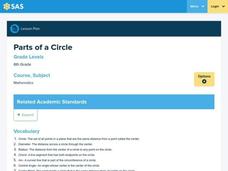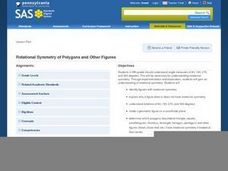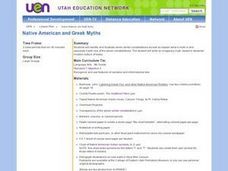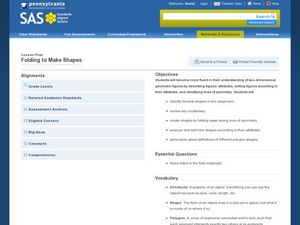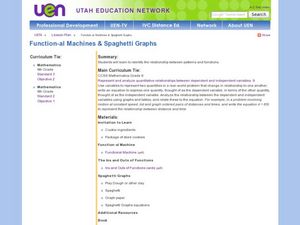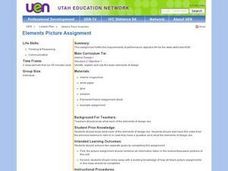Curated OER
Critiquing A Speech Contestant
What makes a speech effective? Middle schoolers critique a speech for content and presentation. They view a video of a middle school student presenting an informational speech, They outline the content of the speech and critique the...
Curated OER
Parts of a Circle
Sixth graders use yarn, paper plate, and other materials to identify parts of a circle. In this parts of a circle lesson plan, 6th graders identify the circumference, radius, diameter, and other parts of a circle.
Utah Education Network (UEN)
Integers on a Coordinate Plane
Boogie fever! Explore the concept of integers on coordinate plane. In this integers on a coordinate plane activity, students graph rational numbers on the coordinate plane and identify coordinates of a point. Students perform a line...
Pennsylvania Department of Education
Rotational Symmetry of Polygons and Other Figures
Learners explore geometry by participating in a shape rotation experiment. In this symmetry lesson plan, students identify the term symmetry and a list of other geometry vocabulary. Learners analyze shapes as they are turned 90 degrees...
Curated OER
Context Clues, Plot Structure, Conflict, and Personal Narrative Essay
What are the elements of a personal narrative? Get your class talking by reading "The Necklace" and "A Dangerous Game." The lesson focuses primarily on defining certain vocabulary terms (like context clues, plot, conflict, climax, etc.)...
Curated OER
Information Problem Solving--Lesson 3 of 5
Students examine a selected story/book and practice identifying the setting, characterization, and plot. As a class, they identify problems in the story, turning points and the climax. They use a rubric to evaluate the story, as well.
Curated OER
Native American and Greek Myths
Fifth graders identify seven different constellations and explain a myth that accompanies it. As a class, they listen to myths associated with the Greek and Native American cultures. To end the activity, they write their own myth...
Curated OER
Jumping Rules
First graders practice identifying number patterns. In this basic patterns lesson, 1st graders use a large number line and jump to certain numbers to create, identify or extend a pattern. This lesson includes a script to guide the teacher.
Curated OER
Folding to Make Shapes
Second graders identify different polygons and their attributes. In this geometry instructional activity, 2nd graders get to know polygons by studying the vocabulary and finding polygons in their classroom. They create these shapes and...
Curated OER
Square Graphs
Students identify the different properties of quadrilaterals. In this geometry-lesson, students define parallel sides and diagonals of polygons as they compare to a quadrilateral. They identify the methods to find the angles in a...
Curated OER
Birth Defects: Fetal Alcohol Syndrome
Students identify the causes, characteristics, and the treatment or prevention of fetal alcohol syndrome. They prepare presentations on birth defects, and listen to a guest speaker discuss birth defects.
Curated OER
Hexagon Island
High schoolers identify different polygons. In this geometry lesson, students name polygons using the number of sides. They calculate distance and slopes using the correct formula.
Curated OER
Function-al Machines and Spaghetti Graphs
Sixth graders identify the relationship between patterns and functions. In this algebra lesson, 6th graders use a "Functional Machine" to identify the rule. Students use a function table to plot the points using play dough dots.
Curated OER
Lines In Geometry
Pupils define important vocabulary words using a dictionary. In this geometry lesson, students identify and use properties of triangles to solve problems. They identify the median. altitude and angles as well as properties of...
Curated OER
Community and Colonization
Eighth graders explore the nature of the European colonization in the Americas. They compare how it relates to the inception of their community. Students identify the major players in America's colonization and explore the motivations...
Curated OER
Mate Selection Theory
Learners study the mate selection theories. They compose their own personal list of characteristics, qualities, and values desired in a marriage partner. They identify and explain the Mate Selection Theory and analyze the importance...
Curated OER
Elements Picture Assignment
Young scholars identify the basic structural and decorative designs, create examples of line (horizontal/vertical/curved/diagonal), as well as identify and explain the difference between shape and form. Then, they identify and explain...
Curated OER
Constructing Tangrams
Sixth graders are introduced to how geometry and algebra are related. In groups, they graph various points on a coordinate plane and write the ordered pair for each quadrant. Using this information, they create their own tangrams to...
Curated OER
New: Around the World
First graders identify and demonstrate how symbols and models are used to represent features of the environment. They use a map and a globe to label where the students in the book came from, point out the continent, and show which ocean...
Curated OER
Triangle Classification
Students classify different types of triangles. In this geometry lesson, students identify and use properties of triangles. They differentiate between isosceles and equilateral triangles.
Curated OER
Location, Location, Location
Students investigate the properties of triangles. In this geometry lesson, students identify the location of different polygons. They identify the different properties of triangles and polygons.
Pennsylvania Department of Education
Analyzing Key Ideas and Details in Nonfiction
Students explore nonfiction texts. In this language arts lesson, students read a nonfiction text and make predictions. Students identify facts and opinions in the text and draw conclusions as they read.
Curated OER
Fashion Terms
Young scholars listen to a lecture on fashion terms and define these words. They identify examples of terms in fashion magazines and take a quiz.
Curated OER
Business Cycles in the Four-Corners
Learners are introduced to new vocabulary associated with business cycles. In groups, they read excerpts from their textbook about the causes and effects of business cycles. To end the instructional activity, they identify the...



